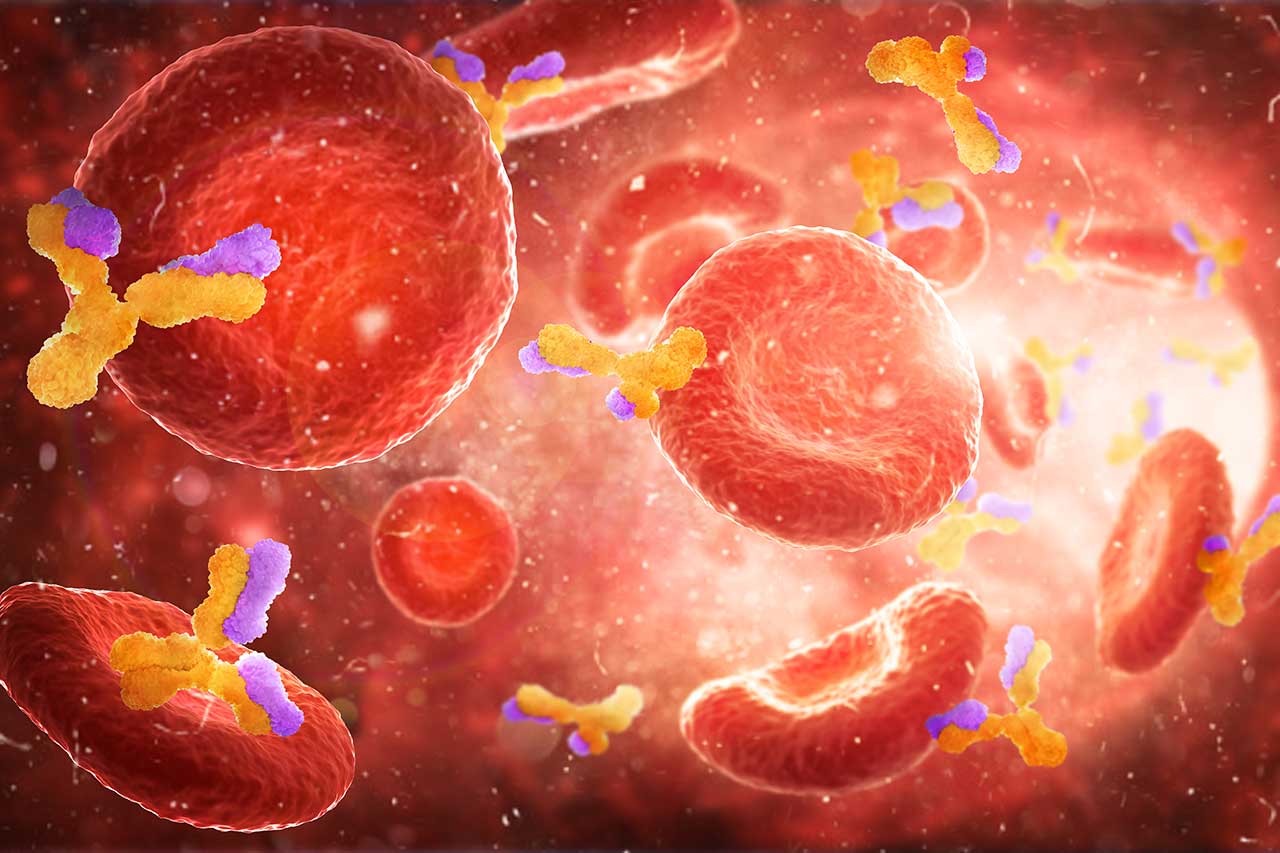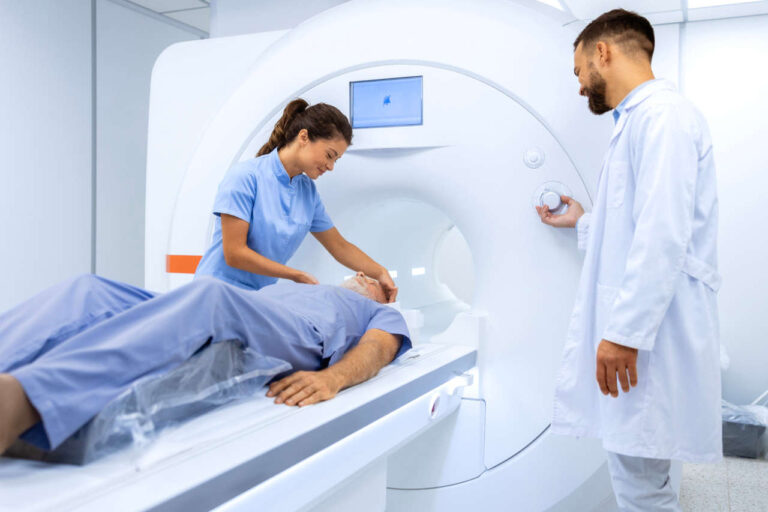
The body defends itself against germs through barriers such as the skin, mucosa, and intestinal or pulmonary cilia (microscopic hairs). When germs manage to overcome these barriers, they can infect the body. To prevent this from happening, the body has an immune system that attacks these disease-causing microorganisms and prevents infections. Gamma globulins are glycoproteins synthesized in response to a foreign antigen (any foreign substance in our systems such as viruses, parasites, or bacteria), specifically binding to them and activating a series of mechanisms through which the immune system is able to eliminate the invading antigen.
Get IVIG Prior Authorization
When gamma globulins are immunologically active, they are also called immunoglobulins or antibodies.
Immunoglobulin Isotypes (Classes)
There are several subtypes of immunoglobulins known as: IgG, IgA, IgM, IgE, and IgD (which can be remembered using the mnemonic, GAMED). They are produced by different immune cells (known as lymphocytes) in different clinical scenarios.
IgG is the most abundant antibody in the blood (plasma). It helps fight infections by viruses and parasites and facilitates immunotherapy for allergies (allergy shots). IgG has anti-inflammatory effects.
IgA is present in mucosal secretions and is responsible for mucosal defense (the mucosa is the moist, inner lining of some organs and body cavities, such as the nose, mouth, lungs, and stomach). It is synthesized in cells of the intestinal lumen and plasma cells. It is the subtype that predominates in colostrum (which is the first form of breastmilk that is released by the mammary glands after giving birth and initially helps the newborn baby’s immune system, especially in the gastrointestinal tract).
IgM is present in lesser amounts in the serum. It plays an important role in the development of B lymphocytes and is produced mainly as the primary immune response to microbial infection/antigen invasion (early recognition of the pathogen).
IgE is found in the extravascular space, and its original role is to protect against parasites. In regions where parasitic infection is rare, IgE is primarily involved in allergic reactions.
IgD is present in small amounts and helps the B lymphocytes to produce more antibodies.
The Role of Vaccines

Vaccines contain inactive or weakened parts of the microorganisms, which produce an immune response within our body. While disease does not occur in people who receive a vaccine, the vaccine will cause their immune system to respond effectively and produce antibodies as if it were in contact for the first time with the real pathogen.
Some vaccines require multiple doses given weeks or months apart. This is necessary for the formation of long-living antibodies and memory cells. This is how the body prepares or trains, by forming a memory of a specific microorganism and combating it quickly if it comes into contact with it in the future.
Increased Immunoglobulins in Plasma: Hyperglobulinemia
There are diseases/conditions in which the number of immunoglobulins can increase in the blood plasma. Such diseases/conditions include:
- Chronic liver diseases such as liver cirrhosis
- Chronic pancreatitis
- Several types of cancer (breast, multiple myeloma, colon, rectum, prostate, bladder, lymphoma, leukemia, and Waldenström macroglobulinemia, among others)
- Collagen disease (rheumatoid arthritis, systemic lupus erythematosus, acute rheumatic fever, acute glomerulonephritis [which is an inflammation and damage to the filtering part of the kidneys (glomerulus)], polyarteritis nodosa, and systemic sclerosis)
- Sarcoidosis
- Hemolytic anemia
- Infectious diseases (leishmaniasis, abscess, miliary tuberculosis, pneumonia, subacute bacterial endocarditis, and tuberculosis)
- Tissue injury of any cause (examples include inflammation, acute bacterial or viral infection, necrosis, neoplasia, or trauma)
Get IVIG Copay Assistance
Speak to a SpecialistDecreased Gamma Globulins: Hypogammaglobulinemia
Hypogammaglobulinemia refers to low amounts of IgG. The causes for this condition can be primary, such as with common variable immune deficiency (CVID), an immune deficiency disease that is caused by a variety of different genetic abnormalities. These abnormalities result in a defect in the capability of immune cells to produce normal amounts of all types of antibodies, including immunoglobulins. People with CVID have an increased risk of infections. CVID is usually diagnosed in adults; however, it also can occur in children. It is considered very serious, and it is very important that a person sees an immunologist if they suspect or know that they might have this disease. The immunologist would then be in charge of carrying out all appropriate tests to diagnose and recommend a treatment for this condition.
Another form of primary immunodeficiency is transient hypogammaglobulinemia of infancy (THI), which is caused by a transitory drop in the levels of immunoglobulin G (IgG). The exact cause of THI is unknown; however, proposed mechanisms include genetic variations in families prone to immunodeficiency.
Hypogammaglobulinemia can also have secondary causes, including:
- Loss of immunoglobulins, which can be either through the kidneys, such as with nephrotic syndrome (a kidney disorder that causes your body to pass too much protein in your urine), or through the gastrointestinal tract, such as with malabsorption/protein-losing enteropathy (a condition due to an abnormality in the flow of the lymphatic system). Loss of Immunoglobulins can also occur secondary to burn injuries due to the loss of body serum.
- Certain medications, specifically antiepileptic drugs (valproate, phenytoin, carbamazepine, lamotrigine, and others), immunosuppressants (mycophenolate mofetil, sulfasalazine, chloroquine, gold salts, or cyclophosphamide and cyclosporine), high-dose steroids, captopril, and imatinib.
- Genetic syndromes such as trisomy 21 (Down syndrome).
- Congenital infections (HIV and CMV).
- Chronic lymphocytic leukemia, non-Hodgkin-lymphoma (NHL), thymoma with immunodeficiency (Good syndrome), and multiple myeloma.
- Protein loss (nephrotic syndrome, lymphangiectasia of the gut, malabsorption, and severe burns).
Replacement Therapy With Intravenous Immunoglobulin (IVIG)
If you have had hypogammaglobulinemia, it’s important for you to be evaluated by a doctor specializing in immunology, who may indicate Ig replacement therapy to prevent infections and secondary complications when any of the aforementioned diseases are present.
IVIG is often used to treat autoimmune diseases. FDA-approved indications for the use of IVIG include:
- Hypogammaglobulinemia (prophylaxis against bacterial infection):
- Primary humoral immunodeficiency disorders (PI)
- Acquired immunodeficiency secondary to malignancy (e.g., B-cell chronic lymphocytic leukemia)
- Immune thrombocytopenic purpura (ITP) (to prevent severe bleeding)
- Kawasaki disease (to prevent coronary artery aneurysms)
- Chronic inflammatory demyelinating polyneuropathy
- Multifocal motor neuropathy
- Dermatomyositis (DM) in adults
- Antiviral prophylaxis (hepatitis A, measles, and varicella)
Note: Labeled indications may vary for different IVIG brands.
Get Your IVIG Dose
At-Home InfusionImmunoglobulin Therapy
The current use of Ig therapies is aimed at replacement in patients with primary immunodeficiencies and immunomodulation in patients with autoimmune diseases. There are many brands on the market, and both intravenous (IV) and subcutaneous routes are used. Each route of administration has its advantages and disadvantages.
Advantages of the IV route are:
- It can achieve rapid plasma levels (the medication exhibits its effect faster).
- It can be administered at 3- to 4-week intervals.
Disadvantages of the IV route are:
- An IV access is needed.
- It’s necessary to interrupt the patient’s schedule for a 3- to 5-hour period.
- The patient often needs to go to a hospital or infusion center (home infusions are possible in the presence of an infusion nurse).
- Side effects may be more frequent in some patients.
- Risk of an infusion reaction.
- Needs to be cautiously used, especially in patients with high blood pressure.
The subcutaneous route, on the other hand, is usually used when IV access is not practical for patients with poor venous access.
Advantages of the subcutaneous route are:
- It provides more even Ig levels compared to IVIG (which has peaks and troughs).
- It has fewer systemic adverse effects than the IV route (better tolerability than IVIG).
- It offers more flexibility in terms of the patient’s schedule.
- There is no need for hospital-based infusion settings (the patient can self-infuse at home without the need of an infusion nurse).
The disadvantages are:
- Local injection site reactions can occur at the site of infusion (usually minor).
- It requires patient reliability (as they would self-infuse the medication).
- It usually requires weekly infusions.
Adverse Reactions Associated With IG Immunotherapy:
The use of this type of therapy can generate some adverse reactions, such as:
Cardiovascular: Chest pain/discomfort, decreased/increased heart rate, hypertension/hypotension, increased heart rate, tachycardia, flushing, heart murmur, and peripheral edema.
Dermatologic: Skin inflammation, bruising, itching at the site of injection or any part of the body, skin rash/irritation, eczema, skin redness, excessive sweating, hives, and skin dryness.
Endocrine and metabolic: Dehydration, increase in lactate dehydrogenase (which usually increases when there is tissue damage/disease), and swelling/inflammation of the thyroid gland.
Gastrointestinal: Abdominal pain/discomfort, diarrhea, nausea, vomiting, stomach virus, canker sores, indigestion, bloating/flatulence, and stomach inflammation.
Genitourinary: Inflammation of the bladder, pain/discomfort when urinating, and urinary tract infection.
Hematologic & oncologic: Anemia, destruction of red blood cells, positive direct Coombs test, hemolytic anemia, and low white blood cell count.
Hepatic: Increase in liver enzymes (ALT, AST, ALP, and direct/indirect bilirubin).
Hypersensitivity reaction: This can be as severe as an anaphylactic reaction.
Infection: Flu and viral infections.
Local reactions at the site of injection: Bruising, redness, nodules, irritation, pain, swelling, inflammation, and induration (an increase of fibrous elements and loss of elasticity).
Nervous system: Chills, dizziness, fatigue, headache, fever, pain, rigors, depression, falling, fibromyalgia syndrome (exacerbation), hypertonia (muscle overactivity), lack of energy/enthusiasm, general discomfort, migraine, muscle weakness, cold sensations, and vertigo (spinning sensation).
Neuromuscular and skeletal: Weakness, back pain, pain in the arms or legs, muscle pain, joint pain, swollen joint (excessive fluids in the joint), muscle spasm, and neck pain.
Respiratory: Asthma, bronchitis, cough, nosebleed, nasal congestion, common cold, pain/irritation in the throat, stuffy nose, inflammation of the sinuses, upper respiratory tract infection, wheezing, shortness of breath, flu-like symptoms, pneumonia, and viral upper respiratory tract infection.
Otic: Ear pain.
Misc: Fever.
Can IVIG help?
Free IVIG Treatment InfoBlack Box Warnings: (Thrombosis, Renal Dysfunction, and Acute Renal Failure)
Thrombosis
Thrombosis may occur with immune globulin products. Risk factors may include: advanced age, prolonged immobilization, hypercoagulable conditions, history of venous or arterial thrombosis, use of estrogens, indwelling central vascular catheters, hyperviscosity, and cardiovascular risk factors. Thrombosis may occur in the absence of known risk factors. For patients at risk of thrombosis, administration should be done at the minimum dose and infusion rate practicable. Adequate hydration should be ensured in patients before administration. Patients at risk of hyperviscosity should be monitored for signs and symptoms of thrombosis and their blood viscosity should be assessed.
Renal dysfunction and acute renal failure (some brands are excluded from this warning)
Renal dysfunction, acute renal failure, osmotic nephrosis, and death may occur in predisposed patients with immune globulin intravenous (IGIV) products. Patients predisposed to renal dysfunction include those with any degree of preexisting renal insufficiency, diabetes mellitus, age greater than 65, volume depletion, sepsis, paraproteinemia, or patients receiving known nephrotoxic drugs. Renal dysfunction and acute renal failure occur more commonly in patients receiving IGIV products containing sucrose. For patients at risk of renal dysfunction or acute renal failure, IGIV products should be administered at the minimum dose and infusion rate practicable. Adequate hydration should be ensured in patients before administration.
FAQs
What does it mean if your gamma globulin is high?
High gamma globulin levels mean that there is a greater production of these proteins in your body. This can be caused by chronic inflammatory diseases, some types of cancer, or even severe states of dehydration.
Is low gamma globulin bad?
Low gamma globulin levels mean that your body cannot produce enough antibodies and that you need to be evaluated by an immunologist, who may indicate replacement therapy to avoid infections.
REFERENCES:
- Thomas A.. Fleisher, Shearer, W. T., Harry W.. Schroeder, Frew, A. J., & Cornelia M.. Weyand. (2019). Clinical Immunology: Principles and Practice. Elsevier.
- Ballow, M. C. (2019). Immunoglobulin therapy: replacement and immunomodulation. In Clinical Immunology (pp. 1143-1153). Elsevier.
- Moticka, E. J. (2015). A historical perspective on evidence-based immunology. Newnes.
- Rich, R. R., Fleisher, T. A., Shearer, W. T., Schroeder Jr, H. W., Frew, A. J., & Weyand, C. M. (2012). Clinical Immunology E-Book: Principles and Practice. Elsevier Health Sciences.
- https://files.brief.vet/2020-05/DDx_Hyperglobulinemia.pdf
- https://www.nature.com/articles/s41598-021-95061-z
- https://ar.iiarjournals.org/content/37/3/1335
- https://www.ncbi.nlm.nih.gov/pmc/articles/PMC7426452/#:~:text=The%20most%20abundant%20immunoglobulin%20in,SIgA%20(9%E2%80%9313).
- https://pubmed.ncbi.nlm.nih.gov/18265652/#:~:text=Background%2Faims%3A%20Although%20hyperglobulinemia%20is,functional%20aspect%20of%20the%20liver.
- https://link.springer.com/article/10.1007/BF01315210
- https://www.ncbi.nlm.nih.gov/pmc/articles/PMC7249492/
- https://www.ncbi.nlm.nih.gov/pmc/articles/PMC4839251/
- https://pubmed.ncbi.nlm.nih.gov/7292018/
- https://www.ncbi.nlm.nih.gov/pmc/articles/PMC3842189/
- https://www.ncbi.nlm.nih.gov/pmc/articles/PMC4389026/
- https://www.rgare.com/knowledge-center/media/articles/hyperglobulinemia-and-risk-assessment-a-case-study
- https://www.ncbi.nlm.nih.gov/pmc/articles/PMC3216365/
- https://www.ncbi.nlm.nih.gov/pmc/articles/PMC371575/
- https://journals.lww.com/co-pulmonarymedicine/blog/OmSharmasBlog/Lists/Posts/Post.aspx?List=3dcf19c3%2Da0e4%2D4fff%2Da091%2Dfa8a252b4485&ID=7&Web=a45f62d2%2D7348%2D4d8c%2Db7e7%2D015efb1fbc98
- https://www.sciencedirect.com/science/article/abs/pii/0002934359900610
- https://pubmed.ncbi.nlm.nih.gov/3623633/
- https://www.ncbi.nlm.nih.gov/pmc/articles/PMC4259107/
- https://pubmed.ncbi.nlm.nih.gov/902533/
- https://www.ncbi.nlm.nih.gov/books/NBK544356/
- https://www.ncbi.nlm.nih.gov/pmc/articles/PMC1074377/#:~:text=Hypogammaglobulinemia%20may%20result%20from%20other,4%2C%205%2C%209)
- https://www.sciencedirect.com/science/article/pii/S1059131111003256#:~:text=The%20disorders%20observed%20after%20carbamazepine,infection%2C7%20and%20visceral%20leishmaniasis
- https://pubmed.ncbi.nlm.nih.gov/20438577/#:~:text=Background%3A%20Mycophenolate%20mofetil%20(MMF),reported%20in%20patients%20receiving%20MMF
- https://www.sciencedirect.com/topics/immunology-and-microbiology/hypogammaglobulinemia
- http://www.pulmocareindia.org/pulmoface/images/pdf/pulmoface/may16/Pulmonary_complications_due_to_cyclophosphamide_induced_hypogammag_obulinaemia_case_study_and_literature_review.pdf
- https://pubmed.ncbi.nlm.nih.gov/1558152/#:~:text=Profound%20hypogammaglobulinemia%20of%20nephrotic%20syndrome,does%20not%20modulate%20IgG%20synthesis
- https://www.ncbi.nlm.nih.gov/pmc/articles/PMC3046182/
- https://www.ncbi.nlm.nih.gov/pmc/articles/PMC2759463/
- https://www.ncbi.nlm.nih.gov/pmc/articles/PMC5610397/#:~:text=IVIG%20treatment%20reduced%20the%20spread,of%20infection%20and%20virus%20production
- https://pubmed.ncbi.nlm.nih.gov/22738394/
- https://ashpublications.org/blood/article/49/3/335/160730/Immunodeficiency-in-patients-with-non-Hodgkin
- https://onlinelibrary.wiley.com/doi/full/10.1002/ijc.24245













